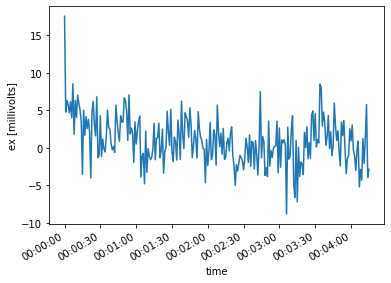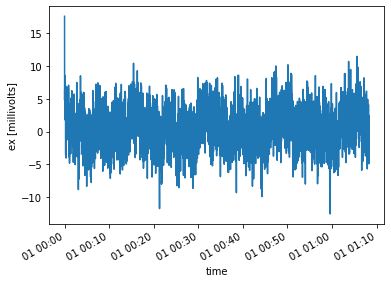ChannelTS
A ChannelTS object is a container for a single channel. The data are stored in an xarray.DataArray and indexed by time according to the metadata provided. Here we will make a simple electric channel and look at how to interogate it.
[1]:
%matplotlib inline
import numpy as np
from mth5.timeseries import ChannelTS
from mt_metadata.timeseries import Electric, Run, Station
2022-09-12 16:26:08,013 [line 135] mth5.setup_logger - INFO: Logging file can be found C:\Users\jpeacock\OneDrive - DOI\Documents\GitHub\mth5\logs\mth5_debug.log
Here create some metadata, the keys are the time_period.start and the sample_rate.
[2]:
ex_metadata = Electric()
ex_metadata.time_period.start = "2020-01-01T00:00:00"
ex_metadata.sample_rate = 1.0
ex_metadata.component = "ex"
ex_metadata.dipole_length = 100.
ex_metadata.units = "millivolts"
Create Station and Run metadata
[3]:
station_metadata = Station(id="mt001")
run_metadata = Run(id="001")
Create “realistic” data
[4]:
n_samples = 4096
t = np.arange(n_samples)
data = np.sum([np.cos(2*np.pi*w*t + phi) for w, phi in zip(np.logspace(-3, 3, 20), np.random.rand(20))], axis=0)
[5]:
ex = ChannelTS(channel_type="electric",
data=data,
channel_metadata=ex_metadata,
run_metadata=run_metadata,
station_metadata=station_metadata)
[6]:
ex
[6]:
Channel Summary:
Station: mt001
Run: 001
Channel Type: electric
Component: ex
Sample Rate: 1.0
Start: 2020-01-01T00:00:00+00:00
End: 2020-01-01T01:08:16+00:00
N Samples: 4096
Get a slice of the data
Here we will provide a start time of the slice and the number of samples that we want the slice to be
[7]:
ex_slice = ex.get_slice("2020-01-01T00:00:00", n_samples=256)
[8]:
ex_slice
[8]:
Channel Summary:
Station: mt001
Run: 001
Channel Type: electric
Component: ex
Sample Rate: 1.0
Start: 2020-01-01T00:00:00+00:00
End: 2020-01-01T00:04:15.062271+00:00
N Samples: 256
Plot the data
This is a work in progress, but this can be done through the xarray container.
[9]:
ex_slice._ts.plot()
[9]:
[<matplotlib.lines.Line2D at 0x219608e90d0>]

Convert to an xarray
We can convert the ChannelTS object to an xarray.DataArray which could be easier to use.
[10]:
ex_xarray = ex.to_xarray()
[11]:
ex_xarray
[11]:
<xarray.DataArray 'ex' (time: 4096)>
array([17.55326313, 4.75550852, 6.32715281, ..., -4.90105606,
-0.4700183 , 2.42377933])
Coordinates:
* time (time) datetime64[ns] 2020-01-01 ... 2020-01-01T01:08:16
Attributes:
channel_number: 0
component: ex
data_quality.rating.value: 0
dipole_length: 100.0
filter.applied: [False]
filter.name: []
measurement_azimuth: 0.0
measurement_tilt: 0.0
negative.elevation: 0.0
negative.id: None
negative.latitude: 0.0
negative.longitude: 0.0
negative.manufacturer: None
negative.type: None
positive.elevation: 0.0
positive.id: None
positive.latitude: 0.0
positive.longitude: 0.0
positive.manufacturer: None
positive.type: None
sample_rate: 1.0
time_period.end: 2020-01-01T01:08:16+00:00
time_period.start: 2020-01-01T00:00:00+00:00
type: electric
units: millivolts
station.id: mt001
run.id: 001[12]:
ex_xarray.plot()
[12]:
[<matplotlib.lines.Line2D at 0x219610d93a0>]

Convert to an Obspy.Trace object
The ChannelTS object can be converted to an obspy.Trace object. This can be useful when dealing with data received from a mainly seismic archive like IRIS. This can also be useful for using some tools provided by Obspy.
Note there is a loss of information when doing this because an obspy.Trace is based on miniSEED data formats which has minimal metadata.
[13]:
ex.station_metadata.fdsn.id = "mt001"
ex_trace = ex.to_obspy_trace()
[14]:
ex_trace
[14]:
.mt001..LQN | 2020-01-01T00:00:00.000000Z - 2020-01-01T01:08:15.000000Z | 1.0 Hz, 4096 samples
Convert from an Obspy.Trace object
We can reverse that and convert an obspy.Trace into a ChannelTS. Again useful when dealing with seismic dominated archives.
[15]:
ex_from_trace = ChannelTS()
ex_from_trace.from_obspy_trace(ex_trace)
[16]:
ex_from_trace
[16]:
Channel Summary:
Station: mt001
Run: None
Channel Type: electric
Component: ex
Sample Rate: 1.0
Start: 2020-01-01T00:00:00+00:00
End: 2020-01-01T01:08:16+00:00
N Samples: 4096
[17]:
ex
[17]:
Channel Summary:
Station: mt001
Run: 001
Channel Type: electric
Component: ex
Sample Rate: 1.0
Start: 2020-01-01T00:00:00+00:00
End: 2020-01-01T01:08:16+00:00
N Samples: 4096
On comparison you can see the loss of metadata information.
Calibrate
ChannelTS.remove_instrument_response is supplied just for this.SEE ALSO: Make Data From IRIS examples for working examples.
[18]:
help(ex.remove_instrument_response)
Help on method remove_instrument_response in module mth5.timeseries.channel_ts:
remove_instrument_response(**kwargs) method of mth5.timeseries.channel_ts.ChannelTS instance
Remove instrument response from the given channel response filter
The order of operations is important (if applied):
1) detrend
2) zero mean
3) zero pad
4) time window
5) frequency window
6) remove response
7) undo time window
8) bandpass
**kwargs**
:param plot: to plot the calibration process [ False | True ]
:type plot: boolean, default True
:param detrend: Remove linar trend of the time series
:type detrend: boolean, default True
:param zero_mean: Remove the mean of the time series
:type zero_mean: boolean, default True
:param zero_pad: pad the time series to the next power of 2 for efficiency
:type zero_pad: boolean, default True
:param t_window: Time domain windown name see `scipy.signal.windows` for options
:type t_window: string, default None
:param t_window_params: Time domain window parameters, parameters can be
found in `scipy.signal.windows`
:type t_window_params: dictionary
:param f_window: Frequency domain windown name see `scipy.signal.windows` for options
:type f_window: string, defualt None
:param f_window_params: Frequency window parameters, parameters can be
found in `scipy.signal.windows`
:type f_window_params: dictionary
:param bandpass: bandpass freequency and order {"low":, "high":, "order":,}
:type bandpass: dictionary